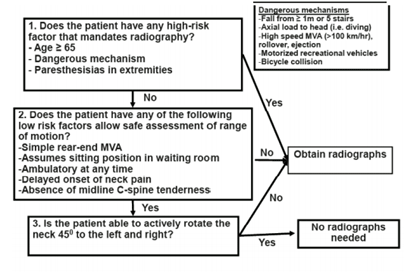In
April 2013, the American Physical Therapy Association (APTA) announced that
all 50 states and the District of Columbia now have direct access to
evaluation. In addition, 48 states plus DC, including Indiana, have some
level of direct access to treatment.
(If you are not a member, please
become one here.)
Just last month, APTA House of Delegates adopted a bold new vision statement
on behalf of our profession "Transforming society by optimizing movement to
improve the human experience."
No matter your opinion on the statement, a close look inward is required.
Are you truly ready for full direct access and to pursue the transformation
of society through your skilled service?
 One of the most important components to being a direct access provider is
the ability to accurately screen for red flags. In a recent case report by
Mathers, Schneider, and Timko (1), the authors describe a patient reported to
clinic with chronic neck pain, “occipital headache that radiated behind her
eyes, dizziness, intermittent paresthesia in the upper extremities
bilaterally, reporting that the neurosurgeon did not find any abnormal
neurological signs.” Additional findings included “past history of trauma,
positive lateral shear test, symptom provocation and arm drift with cervical
rotation/extension, and asymmetrical movement of the C2 spinous process with
lateral flexion.” If this heavily involved patient presented to you without
prior chart review, would you be prepared? One of the most important components to being a direct access provider is
the ability to accurately screen for red flags. In a recent case report by
Mathers, Schneider, and Timko (1), the authors describe a patient reported to
clinic with chronic neck pain, “occipital headache that radiated behind her
eyes, dizziness, intermittent paresthesia in the upper extremities
bilaterally, reporting that the neurosurgeon did not find any abnormal
neurological signs.” Additional findings included “past history of trauma,
positive lateral shear test, symptom provocation and arm drift with cervical
rotation/extension, and asymmetrical movement of the C2 spinous process with
lateral flexion.” If this heavily involved patient presented to you without
prior chart review, would you be prepared?
The best way to avoid being caught off guard is to prepare in-depth intake
forms and review the current literature. Below is a basic review of some red
flags, with important pieces of literature that should be reviewed to
improve ability to provide adequate screening and updated intake procedures.
Red Flags of the Head, Neck, Shoulder
Symptoms/Factors (Yung et al. 2010 (2))
● Constitutional - weight loss, fevers, recent infection
● Age and History of Cancer
○ Common metastatic cancers that cause spine pain are from
prostate, breast, kidney, thyroid, lung, &lymphoma (Remember the mnemonic “lead kettle” = PB KTLL)
● Immunosuppression
○ Think autoimmune diseases, like Crohn’s, Lupus, Rheumatoid
Arthritis in which immunosuppressants are often prescribed.
○ Establish a list of the most common immunosuppressive drugs.
Systems
■ Cardiovascular
○ Cervical Arterial Dysfunction (Kerry et al. 2008(3)) - Using cervical arterial
dysfunction, rather than vertebral insufficiency to allow great
consideration of atherosclerotic risk factors, which may assist in
identifying at-risk patients and patients presenting with frank arterial
pathology.
■ Pulmonary
○ Pulmonary Embolism (Wells et al. 2000 (4))
● Wells Clinical Decision Rules
- Low risk: < 2 points
(3.6% probability)
- Moderate Risk: 2 – 6
points ( 20.5% probability)
- High risk: > 6.0 points
(66.7% probability)
- For specifics, see
Appendix A
■ Gastrointestinal/Hepatic/Biliary/Renal/Urinary
■ Neoplastic Conditions
■ Infections and Inflammatory disorders
■ Musculoskeletal
○ Cervical Myelopathy (Cook et al. 2010 (5)) - Five clinical findings: 1) gait deviation 2)
+Hoffmann’s 3) inverted supinator sign 4) +Babinski test 5) age >45 years
- Combinations of three
of five or four of five tests enabled adjustments of post-test probability
of the condition to 94–99%.
○ Cervical Fracture
○ Canadian C-Spine Rules (Stiell et
al. 2003(6))
- Sensitivity 99.4% (CI
95, 96-100)
- Shows
strong diagnostic utility in ruling out fractures when patient’s negative
for the rule.
- Only 1 missed cervical spine fracture, out of 8283 patients in an emergency
room setting!
- For
specifics, see Appendix B
■ Psychological
○ Depression
-
National Institute of Mental Health suggests a quick 2 question screen. in
which one “yes” answer has shown 96% sensitivity.
“Over the past 2 weeks, have you felt down, depressed or hopeless?”
“Over the past 2 weeks, have you felt little interest or pleasure in doing
things?”
- One “yes” answer has shown 96% sensitivity in ruling in depression.
- Importance demonstrated by George et al. (7), who found that depressive
symptoms had a moderate to large effect on pain ratings and a small to large
effect on functional status.
In summary, neck pain is second only to low back pain in annual workers’
compensation costs in the United States8. It has also been shown that 44% of
patients experiencing neck pain will go on to develop chronic symptoms (9).
Combine these facts with physical therapy’s move towards increased direct
access, and the importance of in-depth, accurate screening has never been
more important. So update your intake forms, use these resources to sharpen
your screening skills and transform society!
Appendix A - Wells Clinical Decision Rules
| Predictor Variable |
Score |
| Clinical signs and
symptoms of DVT |
3.0 |
| No alternative
diagnosis |
3.0 |
| Heart rate >100bpm |
1.5 |
| Immobilization
following surgery in the past 4 weeks |
1.5 |
| Previous DVT/PE |
1.5 |
| Hemoptysis |
1.0 |
| Malignancy |
1.0 |
|
Total |
/12.5 |
Low risk: < 2 points, Moderate Risk: 2 – 6 points, High
risk: > 6.0 points
Appendix B - Canadian C-Spine Rules

Last revised: July 23, 2013
by Nicholas W. Gigliotti, PT, DPT
References
1) Mathers KS, Schneider M, Timko M. Occult hypermobility of
the craniocervical junction: a case report and review. J
Orthop Sports PhysTher. 2011 Jun;41(6):444-57. doi:
10.2519/jospt.2011.3305. Epub 2011 May 31. Review. PubMed
PMID: 21628827.
2) Yung E, Asavasopon S, Godges JJ. Screening for head,
neck, and shoulder pathology in patients with upper
extremity signs and symptoms. J Hand Ther.2010
Apr-Jun;23(2):173-85; quiz 186. doi:
10.1016/j.jht.2009.11.004. Epub 2010 Feb 11.
PubMed PMID: 20149960.
3) Kerry R, Taylor AJ, Mitchell J, McCarthy C, Brew J.
Manual therapy and cervical arterial dysfunction, directions
for the future: a clinical perspective. J Man ManipTher.
2008;16(1):39–48. doi: 10.1179/106698108790818620.
4) Wells PS, Anderson DR, Rodger M, Ginsberg JS, Kearon C,
Gent M, Turpie AG, Bormanis J, Weitz J, Chamberlain M, Bowie
D, Barnes D, Hirsh J. Derivation of a simple clinical model
to categorize patients probability of pulmonary embolism:
increasing the models utility with the SimpliRED D-dimer.
ThrombHaemost. 2000 Mar;83(3):416-20. PubMed PMID: 10744147.
5) Cook C, Brown C, Isaacs R, Roman M, Davis S, Richardson
W. Clustered clinical findings for diagnosis of cervical
spine myelopathy. J Man ManipTher2010;18(4):175–80.
6) Stiell IG, Clement CM, McKnight RD, Brison R, Schull MJ,
Rowe BH, Worthington JR, Eisenhauer MA, Cass D, Greenberg G,
MacPhail I, Dreyer J, Lee JS, Bandiera G, Reardon M, Holroyd
B, Lesiuk H, Wells GA. The Canadian C-spine rule versus the
NEXUS low-risk criteria in patients with trauma.N Engl J
Med. 2003 Dec 25;349(26):2510-8. PubMed PMID: 14695411.
7) George SZ, Coronado RA, Beneciuk JM, Valencia C, Werneke
MW, Hart DL.Depressive symptoms, anatomical region, and
clinical outcomes for patients seeking outpatient physical
therapy for musculoskeletal pain.PhysTher. 2011
Mar;91(3):358-72. doi: 10.2522/ptj.20100192. Epub 2011 Jan
13. PubMed PMID: 21233305; PubMed Central PMCID: PMC3048818.
8) Borghouts JA, Koes BW, Bouter LM. The clinical course and
prognostic factors of non-specific neck pain: a systematic
review. Pain. 1998 Jul;77(1):1-13. Review. PubMed PMID:
9755013.
9) Wright A, Mayer TG, Gatchel RJ.Outcomes of disabling
cervical spine disorders in compensation injuries.A
prospective comparison to tertiary rehabilitation response
for chronic lumbar spinal disorders.Spine (Phila Pa 1976).
1999 Jan 15;24(2):178-83. PubMed PMID: 9926390.
|


 One of the most important components to being a direct access provider is
the ability to accurately screen for red flags. In a recent case report by
Mathers, Schneider, and Timko (1), the authors describe a patient reported to
clinic with chronic neck pain, “occipital headache that radiated behind her
eyes, dizziness, intermittent paresthesia in the upper extremities
bilaterally, reporting that the neurosurgeon did not find any abnormal
neurological signs.” Additional findings included “past history of trauma,
positive lateral shear test, symptom provocation and arm drift with cervical
rotation/extension, and asymmetrical movement of the C2 spinous process with
lateral flexion.” If this heavily involved patient presented to you without
prior chart review, would you be prepared?
One of the most important components to being a direct access provider is
the ability to accurately screen for red flags. In a recent case report by
Mathers, Schneider, and Timko (1), the authors describe a patient reported to
clinic with chronic neck pain, “occipital headache that radiated behind her
eyes, dizziness, intermittent paresthesia in the upper extremities
bilaterally, reporting that the neurosurgeon did not find any abnormal
neurological signs.” Additional findings included “past history of trauma,
positive lateral shear test, symptom provocation and arm drift with cervical
rotation/extension, and asymmetrical movement of the C2 spinous process with
lateral flexion.” If this heavily involved patient presented to you without
prior chart review, would you be prepared?




